Thermal Insulation Foam of Polystyrene/Expanded Graphite Composite with Reduced Radiation and Conduction
Abstract
1. Introduction
2. Materials and Methods
2.1. Materials
2.2. Preparation of PS/EG Composites
2.3. Foaming Process
2.4. Thermal Conductivity Measurement
2.5. Scanning Electron Microscopy Characterization
2.6. Transmission Electron Microscopy Characterization
2.7. Fourier-Transform Infrared Analysis
3. Results and Discussion
3.1. Composite Morphology
3.2. Effect of EG on Radiative Thermal Conductivity in Composite Foams
3.3. Morphology of Composite Foams
3.4. Effect of EG on Total Thermal Conductivity in Composite Foams
4. Conclusions
Supplementary Materials
Author Contributions
Funding
Institutional Review Board Statement
Data Availability Statement
Acknowledgments
Conflicts of Interest
References
- Kang, J.W.; Kim, J.M.; Kim, M.S.; Kim, Y.H.; Kim, W.N.; Jang, W.; Shin, D.S. Effects of nucleating agents on the morphological, mechanical and thermal insulating properties of rigid polyurethane foams. Macromol. Res. 2009, 17, 856–862. [Google Scholar] [CrossRef]
- Modesti, M.; Lorenzetti, A.; Besco, S. Influence of nanofillers on thermal insulating properties of polyurethane nanocomposites foams. Polym. Eng. Sci. 2010, 47, 1351–1358. [Google Scholar] [CrossRef]
- Suvant-Moynot, V.; Gimenez, N.; Sautereau, H. Hydrolytic ageing of syntactic foams for thermal insulation in deep water: Degradation mechanisms and water uptake model. J. Mater. Sci. 2006, 41, 4047–4054. [Google Scholar] [CrossRef]
- Alvarez-Lainez, M.; Rodríguez-Pérez, M.A.; De Saja, J.A. Thermal conductivity of open-cell polyolefin foams. J. Polym. Sci. Part B Polym. Phys. 2008, 46, 212–221. [Google Scholar] [CrossRef]
- Gong, P.; Wang, G.; Tran, M.-P.; Buahom, P.; Zhai, S.; Li, G.; Park, C.B. Advanced bimodal polystyrene/multi-walled carbon nanotube nanocomposite foams for thermal insulation. Carbon 2017, 120, 1–10. [Google Scholar] [CrossRef]
- Glicksman, L.R.; Torpey, M. Factors governing heat transfer through closed cell foam insulation. J. Build. Phys. 1989, 12, 257–269. [Google Scholar] [CrossRef]
- Ferkl, P.; Pokorný, R.; Bobák, M.; Kosek, J. Heat transfer in one-dimensional micro- and nano-cellular foams. Chem. Eng. Sci. 2013, 97, 50–58. [Google Scholar] [CrossRef]
- Schuetz, M.A.; Glicksman, L.R. A basic study of heat transfer through foam insulation. J. Cell. Plast. 1984, 20, 114–121. [Google Scholar] [CrossRef]
- Ferkl, P.; Pokorný, R.; Kosek, J. Multiphase approach to coupled conduction–radiation heat transfer in reconstructed polymeric foams. Int. J. Therm. Sci. 2014, 83, 68–79. [Google Scholar] [CrossRef]
- Placido, E.; Arduini-Schuster, M.C.; Kuhn, J. Thermal properties predictive model for insulating foams. Infrared Phys. Technol. 2005, 46, 219–231. [Google Scholar] [CrossRef]
- Gong, P.; Zhai, S.; Lee, R.; Zhao, C.; Buahom, P.; Li, G.; Park, C.B. Environmentally friendly polylactic acid-based thermal insulation foams blown with supercritical CO2. Ind. Eng. Chem. Res. 2018, 57, 5464–5471. [Google Scholar] [CrossRef]
- Wang, G.; Wang, C.; Zhao, J.; Wang, G.; Park, C.B.; Zhao, G. Modelling of thermal transport through a nanocellular polymer foam: Toward the generation of a new superinsulating material. Nanoscale 2017, 9, 5996–6009. [Google Scholar] [CrossRef] [PubMed]
- Buahom, P.; Wang, C.; Alshrah, M.; Wang, G.; Gong, P.; Tran, M.-P.; Park, C.B. Wrong expectation of superinsulation behavior from largely-expanded nanocellular foams. Nanoscale 2020, 12, 13064–13085. [Google Scholar] [CrossRef] [PubMed]
- Almanza, O.A.; Rodríguez-Pérez, M.A.; De Saja, J.A. Prediction of the radiation term in the thermal conductivity of crosslinked closed cell polyolefin foams. J. Polym. Sci. Part B Polym. Phys. 2000, 38, 993–1004. [Google Scholar] [CrossRef]
- Buahom, P.; Gong, P.; Wang, C.; Yu, H.; Liu, J.; Park, C.B. Carbon as a solution for nanocellular foam superinsulation. Carbon 2022, 189, 319–338. [Google Scholar] [CrossRef]
- Glicksman, L.R. Heat transfer in foams. In Low Density Cellular Plastics: Physical Basis of Behaviour; Hilyard, N.C., Cunningham, A., Eds.; Springer: Dordrecht, The Netherlands, 1994; pp. 104–152. [Google Scholar]
- Breindel, R.M.; Loh, R.R.; Rynd, J.P.; Delaviz, Y.; Polasky, M.E. Thermoplastic Foams and Method of Forming Them Using Nano-Graphite. U.S. Patent US20110064938A1, 20 December 2011. [Google Scholar]
- Vo, C.V.; Bunge, F.; Duffy, J. Advances in thermal insulation of extruded polystyrene foams. In Proceedings of the Blowing Agents and Foaming Processes, Dusseldorf, Germany, 10–11 May 2011. [Google Scholar]
- Vo, C.V.; Bunge, F.; Duffy, J.; Hood, L. Advances in Thermal Insulation of Extruded Polystyrene Foams. Cell. Polym. 2011, 30, 137–156. [Google Scholar] [CrossRef]
- Gong, P.; Buahom, P.; Tran, M.-P.; Saniei, M.; Park, C.B.; Pötschke, P. Heat transfer in microcellular polystyrene/multi-walled carbon nanotube nanocomposite foams. Carbon 2015, 93, 819–829. [Google Scholar] [CrossRef]
- Wang, G.; Wang, L.; Mark, L.H.; Shaayegan, V.; Wang, G.; Li, H.; Zhao, G.; Park, C.B. Ultralow-threshold and lightweight biodegradable porous PLA/MWCNT with segregated conductive networks for high-performance thermal insulation and electromagnetic interference shielding applications. ACS Appl. Mater. Interfaces 2018, 10, 1195–1203. [Google Scholar] [CrossRef]
- Kompan, M.E.; Kompan, F.M.; Gladkikh, P.V.; Terukov, E.I.; Rupyshev, V.G.; Chetaev, Y.V. Thermal conductivity of a composite medium with a disperse graphene filler. Tech. Phys. 2011, 56, 1074–1078. [Google Scholar] [CrossRef]
- Wicklein, B.; Kocjan, A.; Salazar-Alvarez, G.; Carosio, F.; Camino, G.; Antonietti, M.; Bergstroem, L. Thermally insulating and fire-retardant lightweight anisotropic foams based on nanocellulose and graphene oxide. Nat. Nanotechnol. 2015, 10, 277–283. [Google Scholar] [CrossRef]
- Acik, M.; Lee, G.; Mattevi, C.; Chhowalla, M.; Cho, K.; Chabal, Y.J. Unusual infrared-absorption mechanism in thermally reduced graphene oxide. Nat. Mater. 2010, 9, 840–845. [Google Scholar] [CrossRef] [PubMed]
- Balandin, A.A. Thermal properties of graphene and nanostructured carbon materials. Nat. Mater. 2011, 10, 569–581. [Google Scholar] [CrossRef]
- Dresselhaus, M.S.; Dresselhaus, G.; Sugihara, K.; Spain, I.L.; Goldberg, H.A. Graphite Fibers and Filaments; Springer: Berlin/Heidelberg, Germany, 1988. [Google Scholar]
- Goljanian Tabrizi, A.; Arsalani, N.; Mohammadi, A.; Namazi, H.; Saleh Ghadimi, L.; Ahadzadeh, I. Facile synthesis of a MnFe2O4/rGO nanocomposite for an ultra-stable symmetric supercapacitor. New J. Chem. 2017, 41, 4974–4984. [Google Scholar] [CrossRef]
- Yuan, Y.; Zhang, N.; Li, T.; Cao, X.; Long, W. Thermal performance enhancement of palmitic-stearic acid by adding graphene nanoplatelets and expanded graphite for thermal energy storage: A comparative study. Energy 2016, 97, 488–497. [Google Scholar] [CrossRef]
- Tran, M.; Detrembleur, C.; Alexandre, M.; Jerome, C.; Thomassin, J. The influence of foam morphology of multi-walled carbon nanotubes/poly(methyl methacrylate) nanocomposites on electrical conductivity. Polymer 2013, 54, 3261–3270. [Google Scholar] [CrossRef]
- Grignard, B.; Thomassin, J.M.; Gennen, S.; Poussard, L.; Bonnaud, L.; Raquez, J.M.; Dubois, P.; Tran, M.P.; Park, C.B.; Jerome, C.; et al. CO2-blown microcellular non-isocyanate polyurethane (NIPU) foams: From bio- and CO2-sourced monomers to potentially thermal insulating materials. Green Chem. 2016, 18, 2206–2215. [Google Scholar] [CrossRef]
- Rizvi, A.; Tabatabaei, A.; Barzegari, M.R.; Mahmood, S.H.; Park, C.B. In situ fibrillation of CO2-philic polymers: Sustainable route to polymer foams in a continuous process. Polymer 2013, 54, 4645–4652. [Google Scholar] [CrossRef]
- Tran, M.; Thomassin, J.M.; Alexandre, M.; Jerome, C.; Huynen, I.; Detrembleur, C. Nanocomposite foams of polypropylene and carbon nanotubes: Preparation, characterization, and evaluation of their performance as EMI absorbers. Macromol. Chem. Phys. 2015, 216, 1302–1312. [Google Scholar] [CrossRef]
- Montzka, S.A.; Butler, J.H.; Elkins, J.W.; Thompson, T.M.; Clarke, A.D.; Lock, L.T. Present and future trends in the atmospheric burden of ozone-depleting halogens. Nature 1999, 398, 690–694. [Google Scholar] [CrossRef]
- Honeywell. Solstice 1233zd (E) trans-1-chloro-3,3,3-trifluoropropene. Technical Information; Performance Materials and Technologies: Morristown, NJ, USA, 2013. [Google Scholar]
- Faghri, A.; Zhang, Y.; Howell, J.R. Advanced Heat and Mass Transfer; Global Digital Press: Columbia, MO, USA, 2010; pp. 739–793. [Google Scholar]
- Mahan, J.R. Radiation Heat Transfer: A Statistical Approach; John Wiley & Sons: Hoboken, NJ, USA, 2002; p. 49. [Google Scholar]
- Log, T.; Gustafsson, S.E. Transient plane source (TPS) technique for measuring thermal transport properties of building materials. Fire Mater. 1995, 19, 43–49. [Google Scholar] [CrossRef]
- Gustafsson, S.E. Transient plane source techniques for thermal conductivity and thermal diffusivity measurements of solid materials. Rev. Sci. Instrum. 1991, 62, 797–804. [Google Scholar] [CrossRef]
- ASTM D792–00; Standard Test Methods for Density and Specific Gravity (Relative Density) of Plastics by Displacement. D20 Committee, ASTM International: West Conshohocken, PA, USA, 2025. [CrossRef]
- Xu, X.; Park, C.B.; Xu, D.; Pop-Iliev, R. Effects of die geometry on cell nucleation of PS foams blown with CO2. Polym. Eng. Sci. 2003, 43, 1378–1390. [Google Scholar] [CrossRef]
- Oreski, G.; Tscharnuter, D.; Wallner, G.M. Development of methods to determine the infrared-optical properties of polymer films. Macromol. Symp. 2008, 265, 124–133. [Google Scholar] [CrossRef]
- Campo-Arnáiz, R.A.; Rodríguez-Pérez, M.A.; Calvo, B.; de Saja, J.A. Extinction coefficient of polyolefin foams. J. Polym. Sci. Part B Polym. Phys. 2005, 43, 1608–1617. [Google Scholar] [CrossRef]
- Lee, P.C.; Wang, J.; Park, C.B. Extruded open-cell foams using two semicrystalline polymers with different crystallization temperatures. Ind. Eng. Chem. Res. 2006, 45, 175–181. [Google Scholar] [CrossRef]
- Zhu, Z.; Zong, J.H.; Park, C.B.; Choudhary, M. Effect of Loss of Blowing Agents on Thermal Insulation Properties of Polystyrene Foams. J. Heat Transf. 2009, 131, 052603. [Google Scholar] [CrossRef]
- Antunes, M.; Velasco, J.I.; Realinho, V.; Martínez, A.B.; Rodríguez-Pérez, M.-Á.; de Saja, J.A. Heat transfer in polypropylene-based foams produced using different foaming processes. Adv. Eng. Mater. 2009, 11, 811–817. [Google Scholar] [CrossRef]
- Guo, Z.; Yang, J.; Wingert, M.J.; Tomasko, D.L.; Lee, L.J.; Daniel, T. Comparison of carbon nanofibers and activated carbon on carbon dioxide foaming of polystyrene. J. Cell. Plast. 2008, 44, 453–468. [Google Scholar] [CrossRef]
- Zhang, C.; Zhu, B.; Lee, L.J. Extrusion foaming of polystyrene/carbon particles using carbon dioxide and water as co-blowing agents. Polymer 2011, 52, 1847–1855. [Google Scholar] [CrossRef]
- Notario, B.; Pinto, J.; Solorzano, E.; de Saja, J.A.; Dumon, M.; Rodríguez-Pérez, M.A. Experimental validation of the knudsen effect in nanocellular polymeric foams. Polymer 2015, 56, 57–67. [Google Scholar] [CrossRef]
- Schellenberg, J.; Wallis, M. Dependence of thermal properties of expandable polystyrene particle foam on cell size and density. J. Cell. Plast. 2010, 46, 209–222. [Google Scholar] [CrossRef]
- Martínez-Díez, J.A.; Rodríguez-Pérez, M.A.; De Saja, J.A.; Arcos y Rábago, L.O.; Almanza, O.A. The thermal conductivity of a polyethylene foam block produced by a compression molding process. J. Cell. Plast. 2001, 37, 21–42. [Google Scholar] [CrossRef]
- Gedler, G.; Antunes, M.; Borca-Tasciuc, T.; Velasco, J.I.; Ozisik, R. Effects of graphene concentration, relative density and cellular morphology on the thermal conductivity of polycarbonate–graphene nanocomposite foams. Eur. Polym. J. 2016, 75, 190–199. [Google Scholar] [CrossRef]
- Arduini, M.; Manara, J.; Vo, C. Modeling of radiative properties of polystyrene foams containing infrared opacifiers. Cell. Polym. 2016, 35, 49–66. [Google Scholar] [CrossRef]
- Yeh, J.M.; Chang, K.C.; Peng, C.W.; Chand, B.G.; Chiou, S.C.; Huang, H.H.; Lin, C.Y.; Yang, J.C.; Lin, H.R.; Chen, C.L. Preparation and insulation property studies of thermoplastic PMMA-silica nanocomposite foams. Polym. Compos. 2009, 30, 715–722. [Google Scholar] [CrossRef]
- Ruckdeschel, P.; Philipp, A.; Retsch, M. Understanding thermal insulation in porous, particulate materials. Adv. Funct. Mater. 2017, 27, 1702256. [Google Scholar] [CrossRef]
- Li, T.; Song, J.; Zhao, X.; Yang, Z.; Pastel, G.; Xu, S.; Jia, C.; Dai, J.; Chen, C.; Gong, A.; et al. Anisotropic, lightweight, strong, and super thermally insulating nanowood with naturally aligned nanocellulose. Sci. Adv. 2018, 4, eaar3724. [Google Scholar] [CrossRef]
- Zhao, H.-B.; Chen, M.; Chen, H.-B. Thermally insulating and flame-retardant polyaniline/pectin aerogels. ACS Sustain. Chem. Eng. 2017, 5, 7012–7019. [Google Scholar] [CrossRef]
- Maleki, H.; Montes, S.; Hayati-Roodbari, N.; Putz, F.; Huesing, N. Compressible, thermally insulating, and fire retardant aerogels through self-assembling silk fibroin biopolymers inside a silica structure—An approach towards 3D printing of aerogels. ACS Appl. Mater. Interfaces 2018, 10, 22718–22730. [Google Scholar] [CrossRef]
- Alshrah, M.; Tran, M.-P.; Gong, P.; Naguib, H.E.; Park, C.B. Development of high-porosity resorcinol formaldehyde aerogels with enhanced mechanical properties through improved particle necking under CO2 supercritical conditions. J. Colloid Interface Sci. 2017, 485, 65–74. [Google Scholar] [CrossRef]
- Park, C.B.; Behravesh, A.H.; Venter, R.D. Low density microcellular foam processing in extrusion using CO2. Polym. Eng Sci. 1998, 38, 1812–1823. [Google Scholar] [CrossRef]
- Vargaftik, N.B. Handbook of Thermal Conductivity of Liquids and Gases; Taylor & Francis: Abingdon, UK, 1993. [Google Scholar]
- Limited, R.T. Blowing Agent Systems: Formulations and Processing; Rapra Technology Ltd.: Shrewsbury, UK, 1998. [Google Scholar]
- Zhao, C.Y.; Lu, T.J.; Hodson, H.P. Thermal radiation in ultralight metal foams with open cells. Int. J. Heat Mass. Transfer. 2004, 47, 2927–2939. [Google Scholar] [CrossRef]
- Wei, G.; Liu, Y.; Zhang, X.; Du, X. Radiative heat transfer study on silica aerogel and its composite insulation materials. J. Non-Cryst. Solids 2013, 362, 231–236. [Google Scholar] [CrossRef]
- Baillis, D.; Raynaud, M.; Sacadura, J.F. Spectral radiative properties of open-cell foam insulation. J. Thermophys. Heat Transfer. 1999, 13, 292–298. [Google Scholar] [CrossRef]
- Glicksman, L.; Schuetz, M.; Sinofsky, M. Radiation heat transfer in foam insulation. Int. J. Heat Mass. Transfer. 1987, 30, 187–197. [Google Scholar] [CrossRef]
- Kuhn, J.; Ebert, H.P.; Arduini-Schuster, M.C.; Büttner, D.; Fricke, J. Thermal transport in polystyrene and polyurethane foam insulations. Int. J. Heat Mass. Transfer. 1992, 35, 1795–1801. [Google Scholar] [CrossRef]
- Wu, J.; Sung, W.; Chu, H. Thermal conductivity of polyurethane foams. Int. J. Heat Mass. Transfer. 1999, 42, 2211–2217. [Google Scholar] [CrossRef]
- Tseng, C.; Kuo, K. Thermal radiative properties of phenolic foam insulation. J. Quant. Spectrosc. Radiat. Transfer. 2002, 72, 349–359. [Google Scholar] [CrossRef]


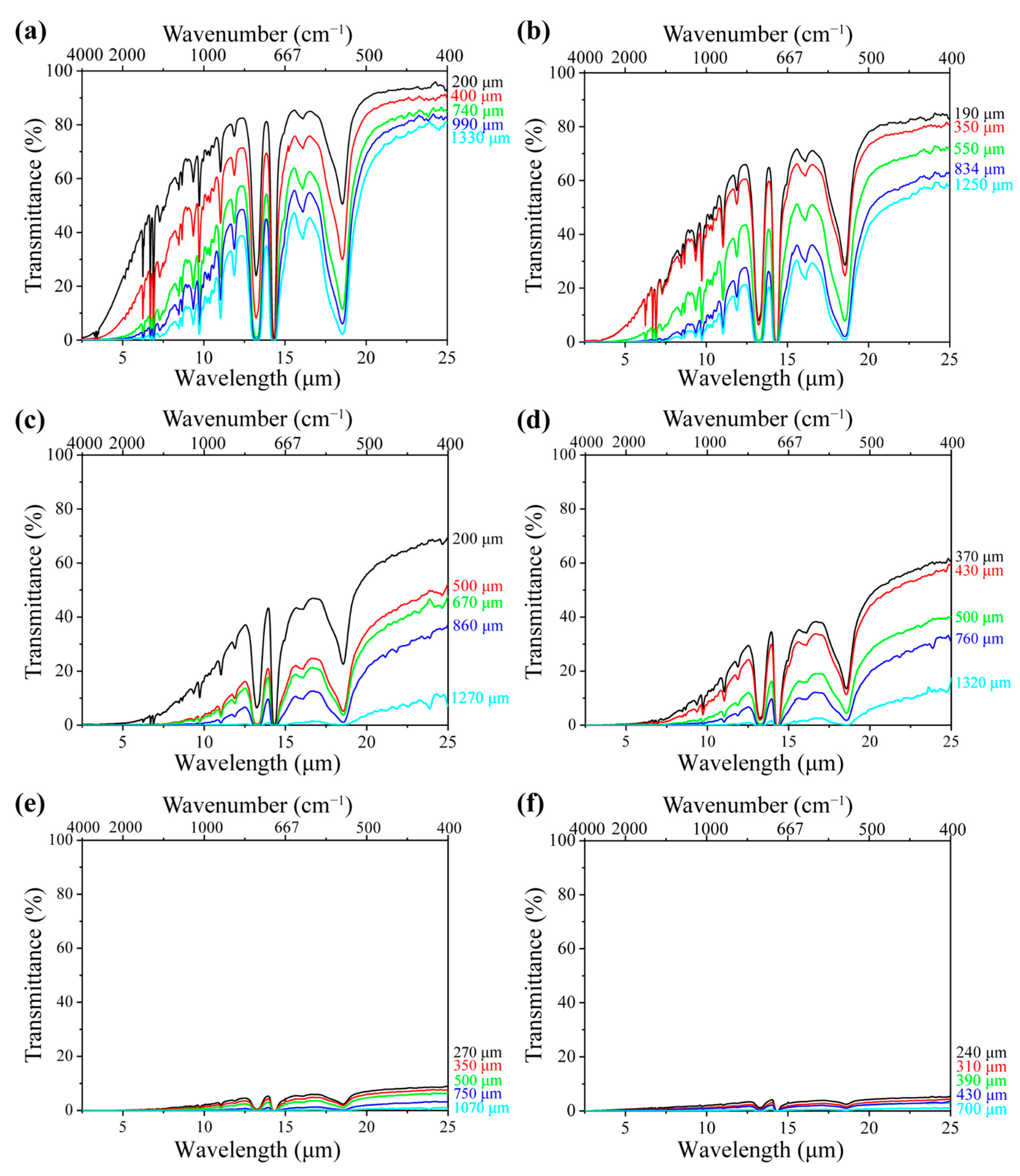
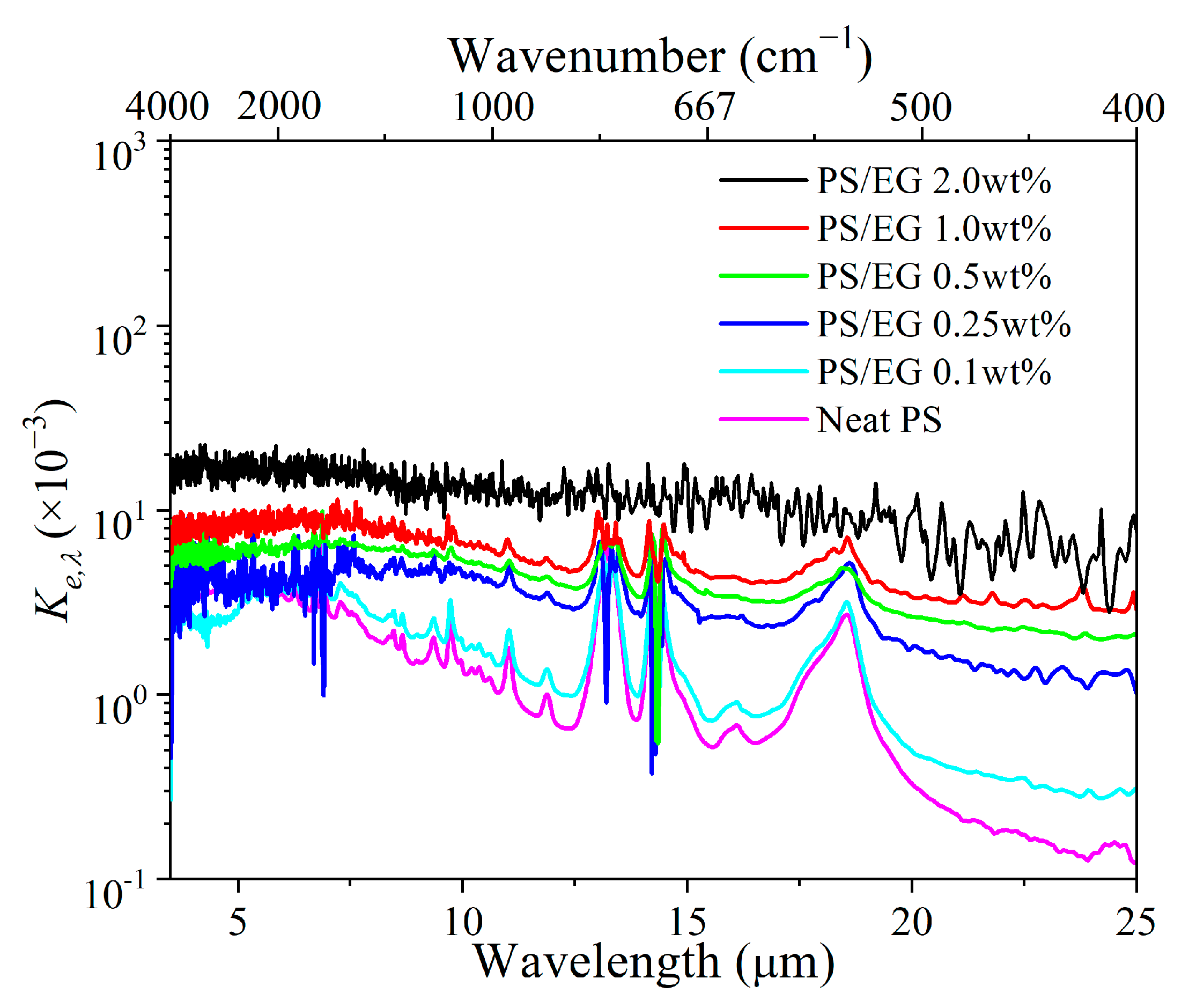
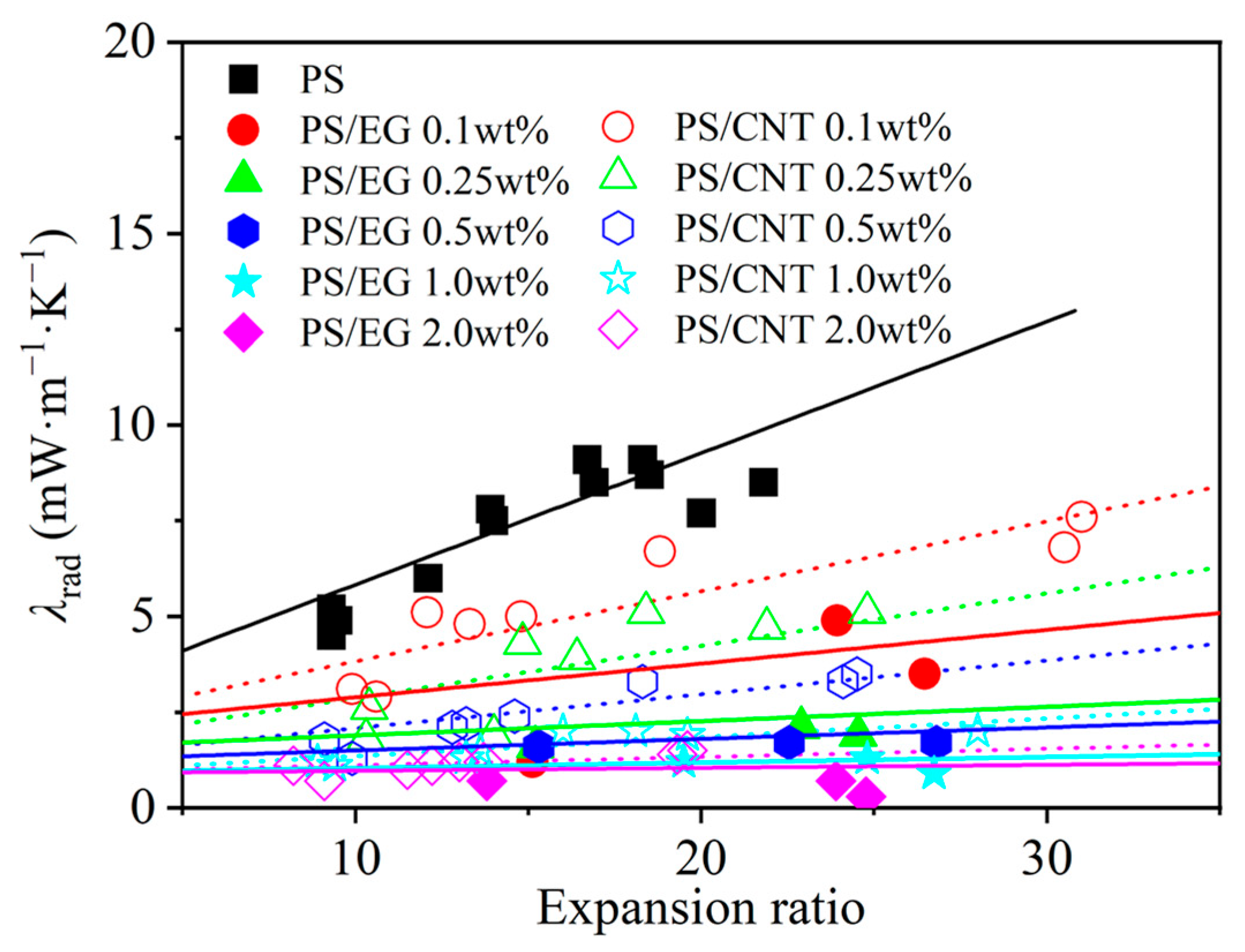
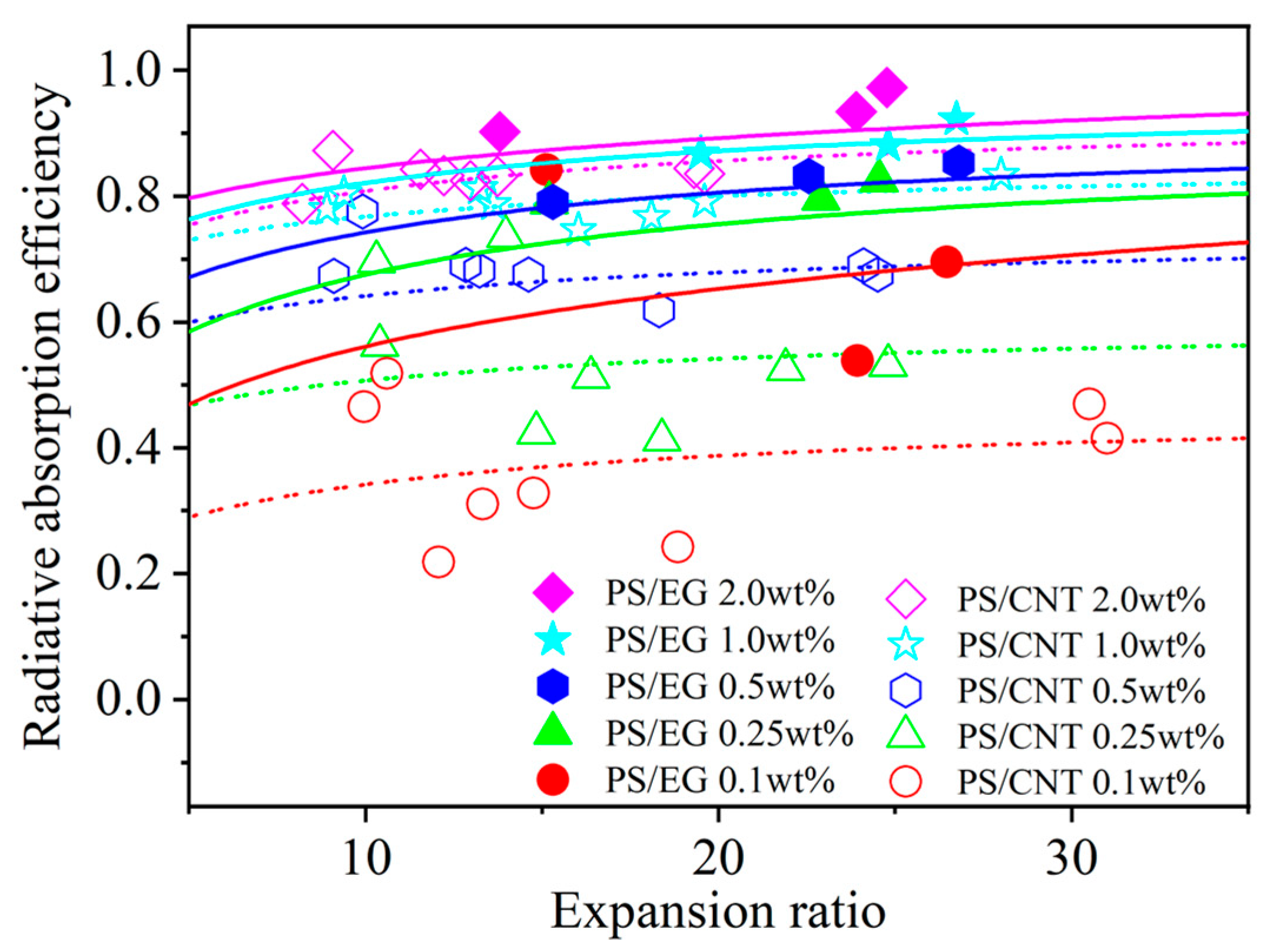
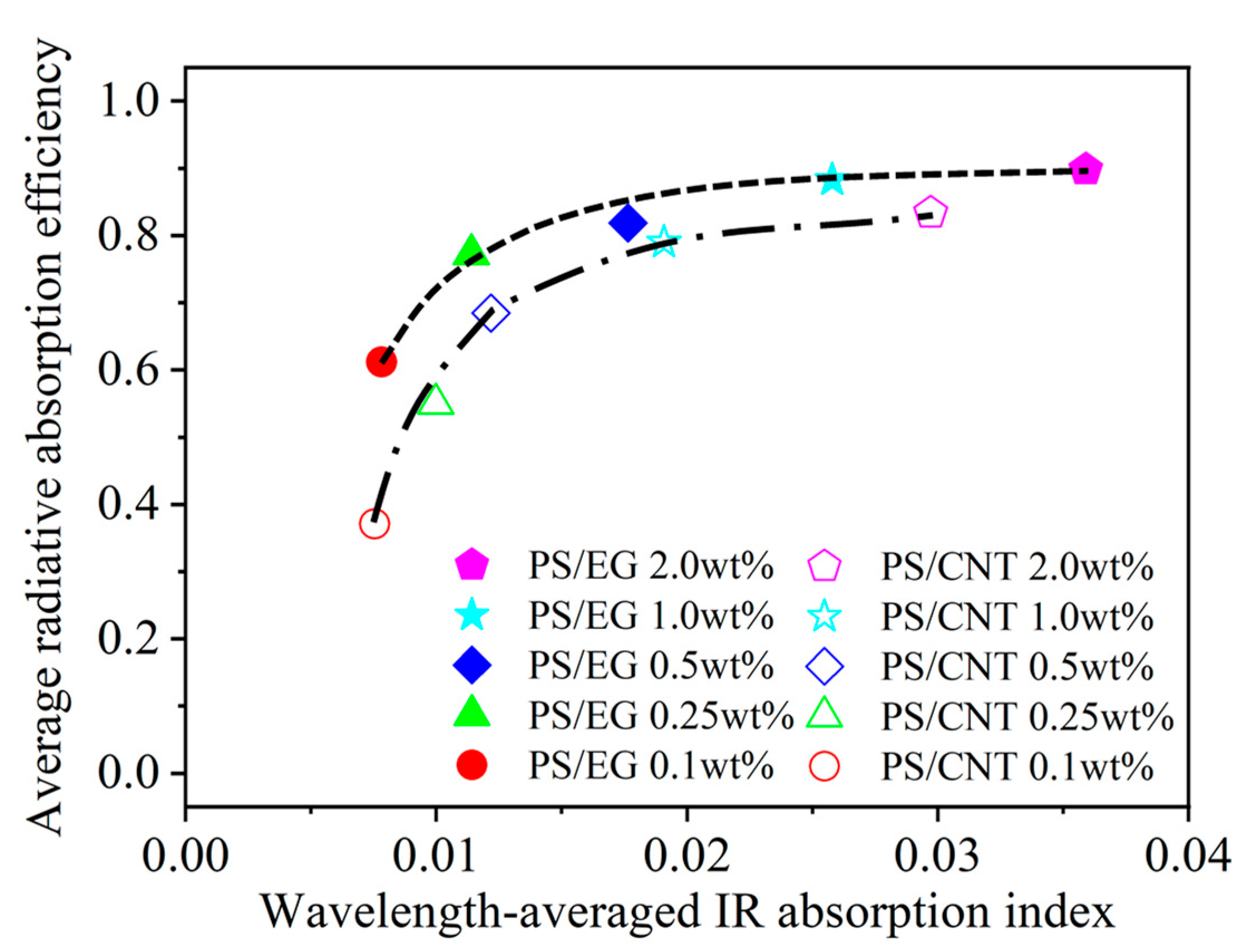
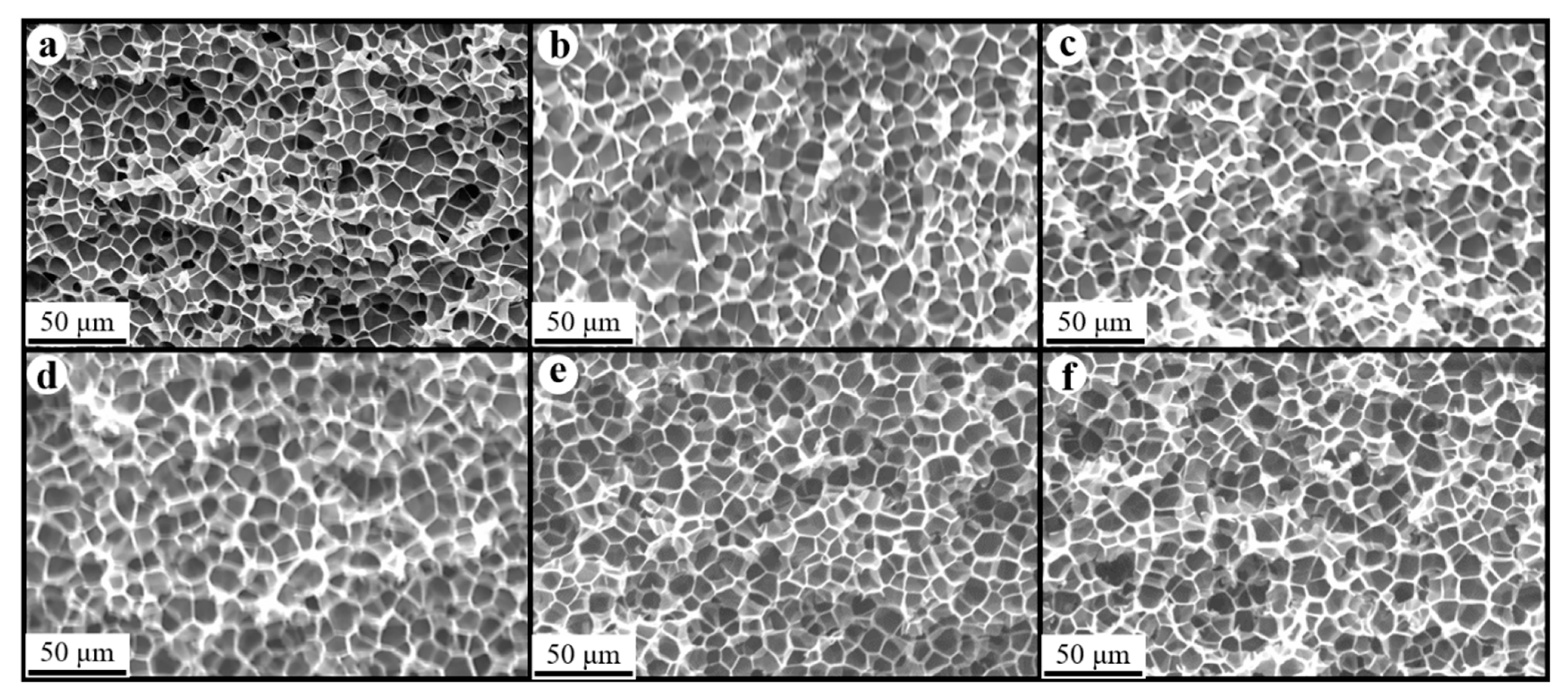
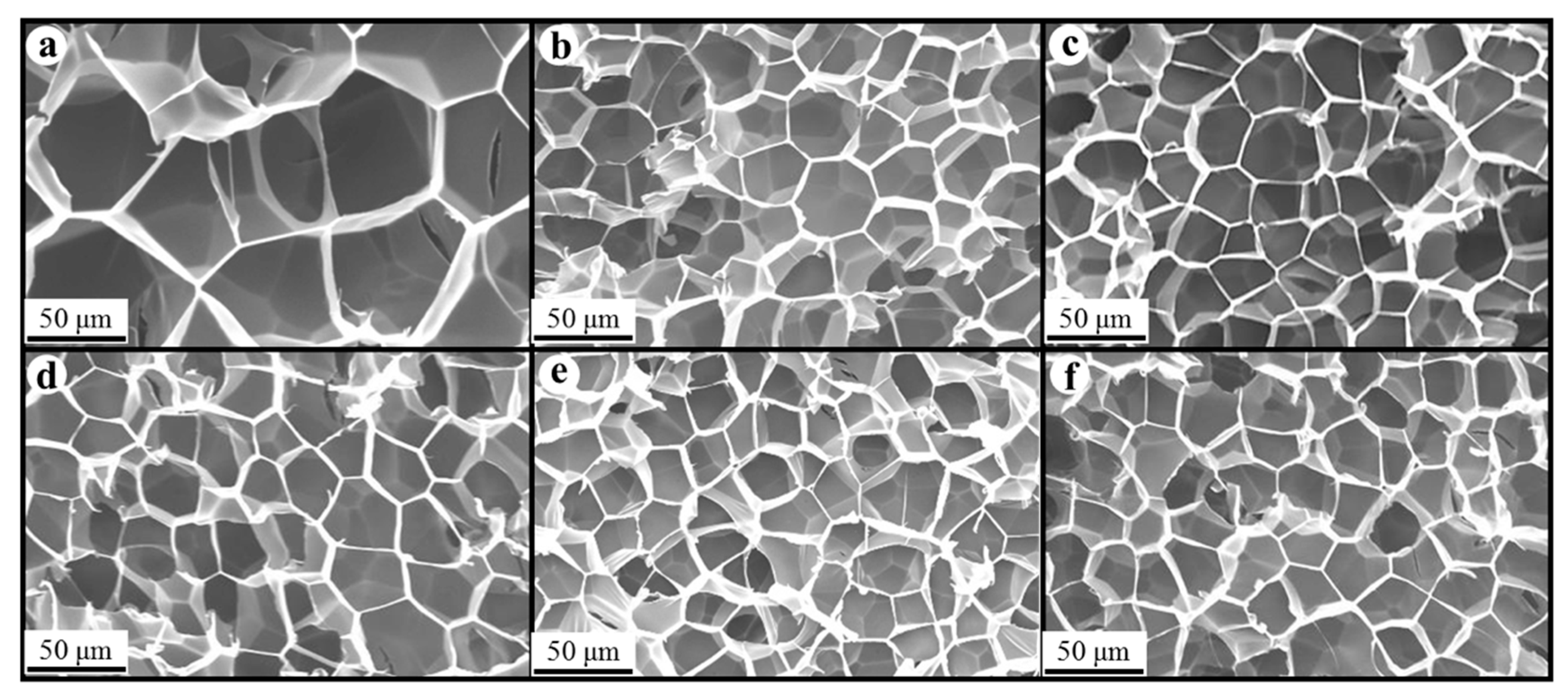
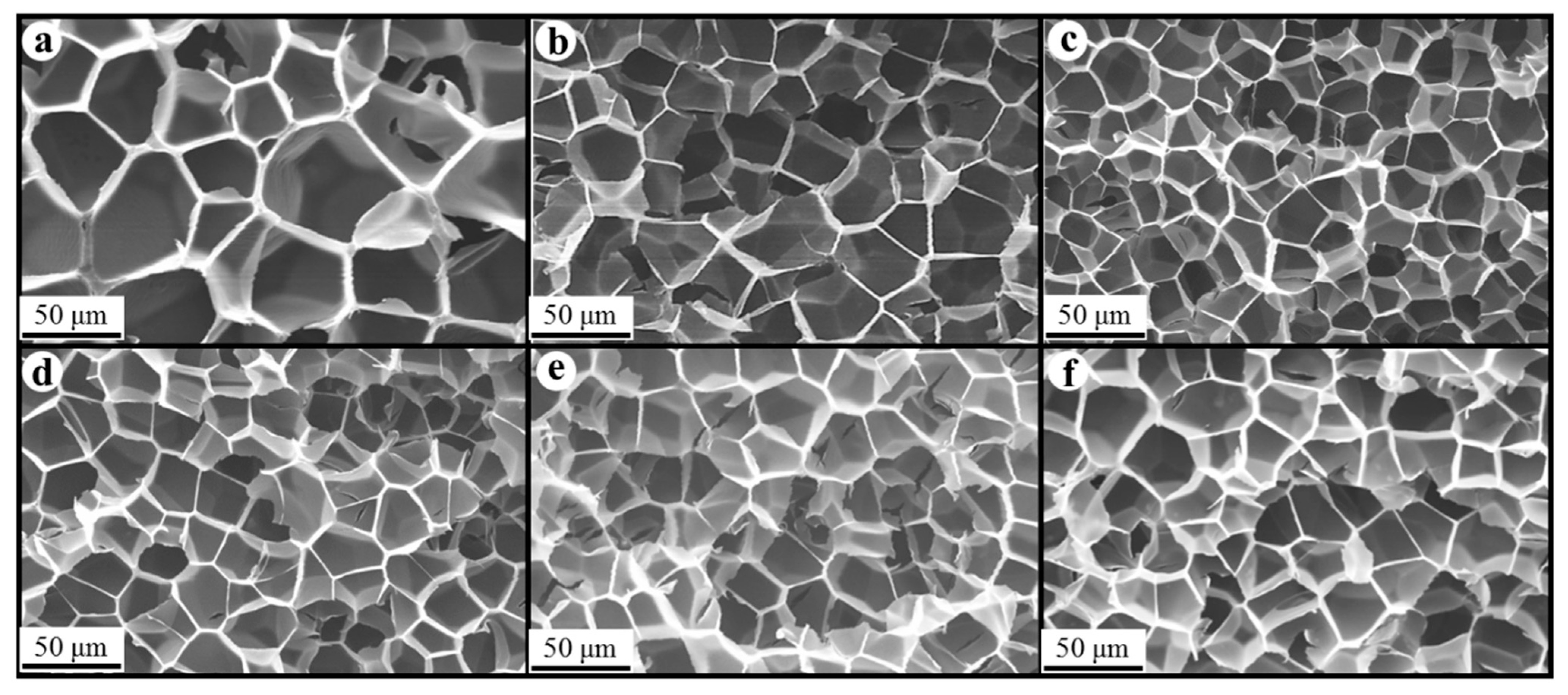

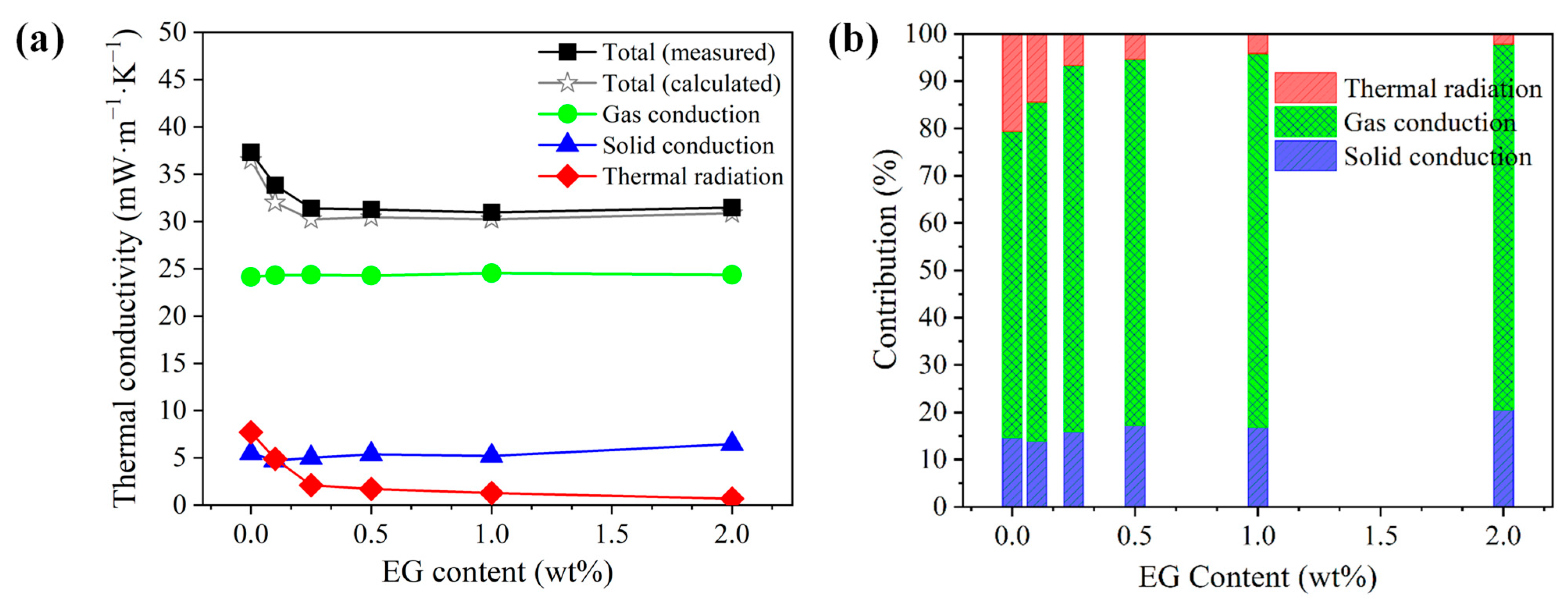

| Filler Content (wt%) | Wavelength-Averaged IR Absorption Index (×103) | |
|---|---|---|
| EG | CNT [5] | |
| 0.0 | 4.32 | 4.32 |
| 0.1 | 7.82 | 7.54 |
| 0.25 | 11.4 | 9.97 |
| 0.5 | 17.5 | 12.2 |
| 1.0 | 25.2 | 19.0 |
| 2.0 | 35.9 | 29.7 |
Disclaimer/Publisher’s Note: The statements, opinions and data contained in all publications are solely those of the individual author(s) and contributor(s) and not of MDPI and/or the editor(s). MDPI and/or the editor(s) disclaim responsibility for any injury to people or property resulting from any ideas, methods, instructions or products referred to in the content. |
© 2025 by the authors. Licensee MDPI, Basel, Switzerland. This article is an open access article distributed under the terms and conditions of the Creative Commons Attribution (CC BY) license (https://creativecommons.org/licenses/by/4.0/).
Share and Cite
Gong, P.; Tran, M.-P.; Buahom, P.; Detrembleur, C.; Thomassin, J.-M.; Kenig, S.; Wang, Q.; Park, C.B. Thermal Insulation Foam of Polystyrene/Expanded Graphite Composite with Reduced Radiation and Conduction. Polymers 2025, 17, 1040. https://doi.org/10.3390/polym17081040
Gong P, Tran M-P, Buahom P, Detrembleur C, Thomassin J-M, Kenig S, Wang Q, Park CB. Thermal Insulation Foam of Polystyrene/Expanded Graphite Composite with Reduced Radiation and Conduction. Polymers. 2025; 17(8):1040. https://doi.org/10.3390/polym17081040
Chicago/Turabian StyleGong, Pengjian, Minh-Phuong Tran, Piyapong Buahom, Christophe Detrembleur, Jean-Michel Thomassin, Samuel Kenig, Quanbing Wang, and Chul B. Park. 2025. "Thermal Insulation Foam of Polystyrene/Expanded Graphite Composite with Reduced Radiation and Conduction" Polymers 17, no. 8: 1040. https://doi.org/10.3390/polym17081040
APA StyleGong, P., Tran, M.-P., Buahom, P., Detrembleur, C., Thomassin, J.-M., Kenig, S., Wang, Q., & Park, C. B. (2025). Thermal Insulation Foam of Polystyrene/Expanded Graphite Composite with Reduced Radiation and Conduction. Polymers, 17(8), 1040. https://doi.org/10.3390/polym17081040












